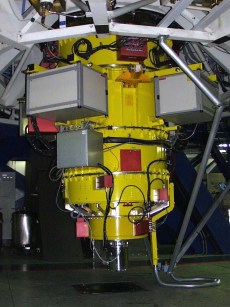FORS - FOcal Reducer and low dispersion Spectrograph
Summary
 FORS is the visual and near UV FOcal Reducer and low dispersion Spectrograph for the Very Large Telescope (VLT) of the European Southern Observatory (ESO). Two versions of FORS have been built, upgraded and moved to the Cassegrain foci of different telescopes in the past years. In April 2009, FORS1 was dismounted to make room for X-shooter, so only FORS2 is in operation. FORS is designed as an all-dioptric instrument for the wavelength range from 330 nm to 1100 nm and provides an image scale of 0".25/pixel (or 0".125/pixel with the high resolution collimator) in the standard readout mode (2x2 binning). FORS2 is installed on UT1 (Antu) and is by default equipped with a detector system that is optimised for the red with a very low level of fringes thanks to a mosaic of two 2k x 4k MIT CCDs (with 15 μm pixels). However, the blue-optimised detector system that was previously available on FORS1 has been commissioned on FORS2 and can be requested for Visitor Mode observation. The geometries of both detector systems are similar, with the optical axis falling ~30" above the gap and offsets of a few arc-seconds between the two chips. FORS2 has many modes, including multi-object spectroscopy with exchangable masks, long-slit spectroscopy (maximum spectral resolution 2600 with a 1" slit), imaging and spectro-polarimetry and high-time resolution imaging and spectroscopy.
FORS is the visual and near UV FOcal Reducer and low dispersion Spectrograph for the Very Large Telescope (VLT) of the European Southern Observatory (ESO). Two versions of FORS have been built, upgraded and moved to the Cassegrain foci of different telescopes in the past years. In April 2009, FORS1 was dismounted to make room for X-shooter, so only FORS2 is in operation. FORS is designed as an all-dioptric instrument for the wavelength range from 330 nm to 1100 nm and provides an image scale of 0".25/pixel (or 0".125/pixel with the high resolution collimator) in the standard readout mode (2x2 binning). FORS2 is installed on UT1 (Antu) and is by default equipped with a detector system that is optimised for the red with a very low level of fringes thanks to a mosaic of two 2k x 4k MIT CCDs (with 15 μm pixels). However, the blue-optimised detector system that was previously available on FORS1 has been commissioned on FORS2 and can be requested for Visitor Mode observation. The geometries of both detector systems are similar, with the optical axis falling ~30" above the gap and offsets of a few arc-seconds between the two chips. FORS2 has many modes, including multi-object spectroscopy with exchangable masks, long-slit spectroscopy (maximum spectral resolution 2600 with a 1" slit), imaging and spectro-polarimetry and high-time resolution imaging and spectroscopy.
Publications based on data obtained with the FORS instruments should quote the following reference paper: Appenzeller, I. et al. 1998, The Messenger 94, 1.
Contact Information
- Questions related to proposal preparation, service mode, and visitor mode observations should be addressed via the contact form at ESO Operations Helpdesk.
- Please, send us your general feedback, comments, suggestions, or report errors and inaccurate statements in the web pages and manuals also via this contact form.
Content of these pages
The following items are available on all the FORS pages, using the bar on the left.
- Overview: a short description of the instrument
- News: list of changes affecting the instrument and/or its pages.
- Instrument Description: all the important parameters of the instrument.
- Manuals: links to all the documents related to FORS.
- Tools: a collection of useful tools and informations for preparing and analyzing the FORS observations.
- Instrument Operations Team
- Visitor Instructions: Instrument specific instructions for Visiting Astronomers
